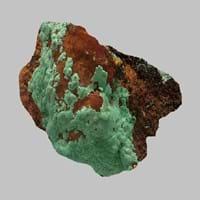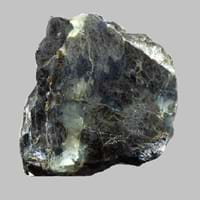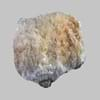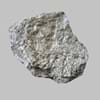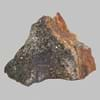Definition
Gossan is intensely oxidized, weathered or decomposed rock, usually the upper and exposed part of an ore deposit or mineral vein.
Pyroxenite is a dark, greenish, granular intrusive igneous rock consisting mainly of pyroxenes and olivine
Discoverer
Cornish Gossen
Unknown
Etymology
From Cornish gossen from gos, blood from Old Cornish guit
From pyro- fire + Greek xenos stranger as the mineral group was new to igneous rocks
Class
Metamorphic Rocks
Igneous Rocks
Sub-Class
Durable Rock, Medium Hardness Rock
Durable Rock, Hard Rock
Group
Not Applicable
Plutonic
Other Categories
Fine Grained Rock, Medium Grained Rock, Opaque Rock
Coarse Grained Rock, Opaque Rock
Texture
Rough, Sandy
Clastic, Granular, Phaneritic, Porphyritic
Color
Brown, Brown- Black, Gold, Green, Rust
Black to Grey, Bluish - Grey, Dark Greenish - Grey, Green, Light Greenish Grey
Durability
Durable
Durable
Scratch Resistant
Yes
Yes
Appearance
Dull and Banded
Layered, Banded, Veined and Shiny
Interior Uses
Countertops, Decorative Aggregates, Interior Decoration
Countertops, Decorative Aggregates, Interior Decoration, Kitchens
Exterior Uses
As Building Stone, As Facing Stone, Paving Stone, Garden Decoration, Office Buildings
As Building Stone, As Facing Stone
Other Architectural Uses
Curbing
Curbing
Construction Industry
As Dimension Stone, Cement Manufacture, Construction Aggregate, for Road Aggregate
As Dimension Stone, Building houses or walls, Cement Manufacture, Construction Aggregate, for Road Aggregate
Medical Industry
Not Yet Used
Not Yet Used
Antiquity Uses
Artifacts
Artifacts
Commercial Uses
Cemetery Markers, Commemorative Tablets, Gemstone
Cemetery Markers, Commemorative Tablets, Laboratory bench tops, Jewelry, Sea Defence, Tombstones
Types
Translocated gossan and Leakage gossan
Clinopyroxenites, Orthopyroxenites and Websterites
Features
Clasts are smooth to touch, Easily splits into thin plates
Generally rough to touch, Host rock for Diamond, Is one of the oldest rock
Archaeological Significance
Monuments
Not Yet Used
Not Yet Used
Famous Monuments
Not Applicable
Not Applicable
Sculpture
Not Yet Used
Not Yet Used
Famous Sculptures
Not Applicable
Not Applicable
Pictographs
Used
Not Used
Petroglyphs
Used
Not Used
Figurines
Not Yet Used
Not Yet Used
Formation
Earth movements can cause rocks to be either deeply buried or squeezed and hence the rocks are heated and put under great pressure.
Pyroxenites are ultramafic igneous rocks which are made up of minerals of the pyroxene group, such as augite and diopside, hypersthene, bronzite or enstatite.
Mineral Content
Apatite, Augite, Biotite, Bronzite, Calcite, Chert, Epidote, Feldspar, Hornblende, Micas, Plagioclase, Pyroxene, Quartz, Sulfides, Zircon
Amphibole, Augite, Bronzite, Chromite, Diopside, Enstatite, Garnet, Hornblende, Hypersthene, Magnetite, Pyroxene
Compound Content
Aluminium Oxide, CaO, Fe, FeO, Silicon Dioxide, Sulphur
Aluminium Oxide, CaO, Chromium(III) Oxide, Iron(III) Oxide, Potassium Oxide, MgO, Sodium Oxide, Silicon Dioxide, Sulfur Trioxide
Types of Metamorphism
Not Applicable
Burial Metamorphism, Impact Metamorphism, Regional Metamorphism
Types of Weathering
Not Applicable
Biological Weathering, Chemical Weathering, Mechanical Weathering
Types of Erosion
Chemical Erosion, Sea Erosion, Wind Erosion
Chemical Erosion, Coastal Erosion, Water Erosion
Grain Size
Fine to Medium Grained
Coarse Grained
Fracture
Conchoidal
Uneven
Streak
White to Grey
White, Greenish White or Grey
Porosity
Highly Porous
Less Porous
Luster
Metallic
Dull to Vitreous to Submetallic
Cleavage
Not Available
Irregular
Toughness
Not Available
Not Available
Specific Gravity
2.0
3.2-3.5
Transparency
Opaque
Opaque
Density
Not Available
3.1-3.6 g/cm3
Specific Heat Capacity
Not Available
Resistance
Heat Resistant, Impact Resistant, Pressure Resistant
Impact Resistant, Pressure Resistant, Wear Resistant
Deposits in Eastern Continents
Asia
China, India, Indonesia, Russia, Singapore, South Korea
India, Russia
Africa
Cape Verde, Ethiopia, Ghana, South Africa, Western Africa
South Africa
Europe
Albania, France, Germany, Great Britain, United Kingdom
Germany, Greece, Italy, Scotland, Turkey
Others
Not Yet Found
Greenland
Deposits in Western Continents
North America
Canada, USA
Canada, USA
South America
Brazil, Colombia, Ecuador
Brazil, Colombia, Venezuela
Deposits in Oceania Continent
Australia
New South Wales, South Australia, Western Australia
New Zealand, Queensland
All about Gossan and Pyroxenite Properties
Know all about Gossan and Pyroxenite properties here. All properties of rocks are important as they define the type of rock and its application. Gossan belongs to Metamorphic Rocks while Pyroxenite belongs to Igneous Rocks.Texture of Gossan is Rough, Sandy whereas that of Pyroxenite is Clastic, Granular, Phaneritic, Porphyritic. Gossan appears Dull and Banded and Pyroxenite appears Layered, Banded, Veined and Shiny. The luster of Gossan is metallic while that of Pyroxenite is dull to vitreous to submetallic. Gossan is available in brown, brown- black, gold, green, rust colors whereas Pyroxenite is available in black to grey, bluish - grey, dark greenish - grey, green, light greenish grey colors. The commercial uses of Gossan are cemetery markers, commemorative tablets, gemstone and that of Pyroxenite are cemetery markers, commemorative tablets, laboratory bench tops, jewelry, sea defence, tombstones.
